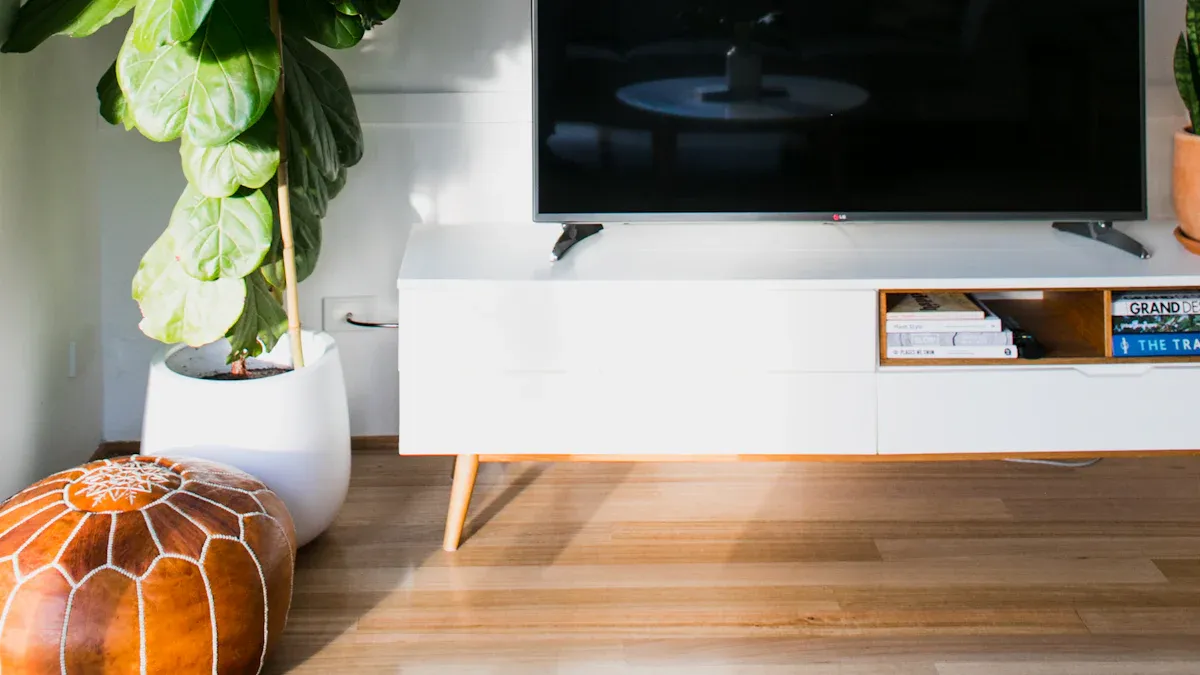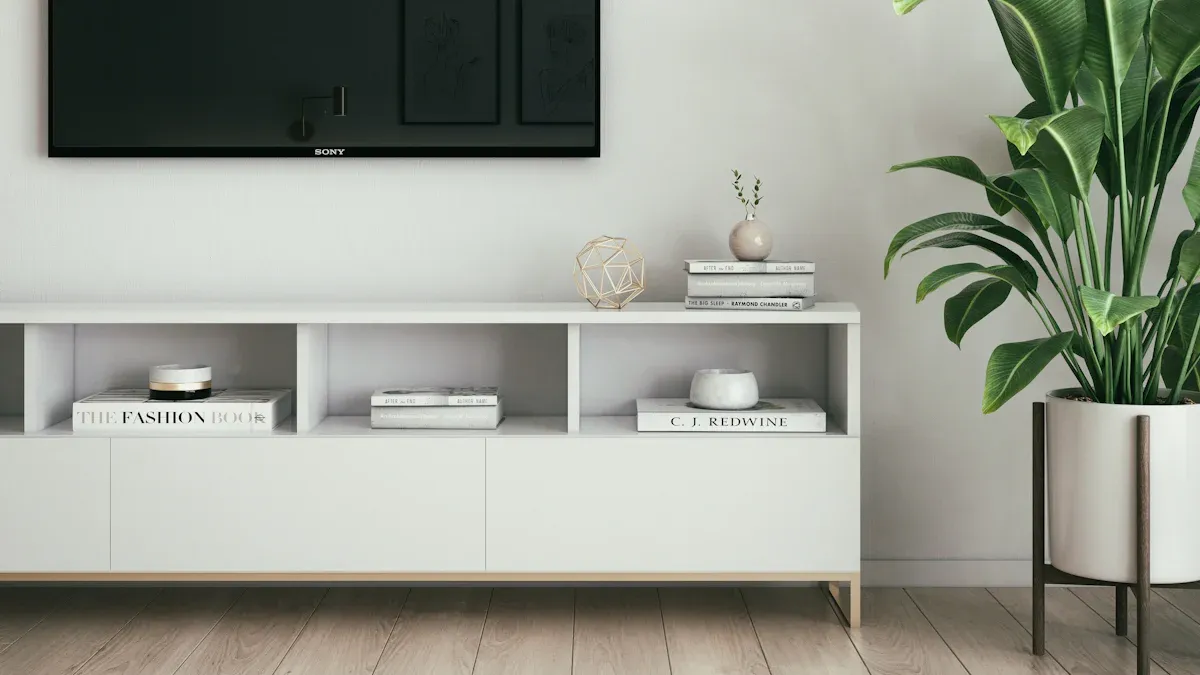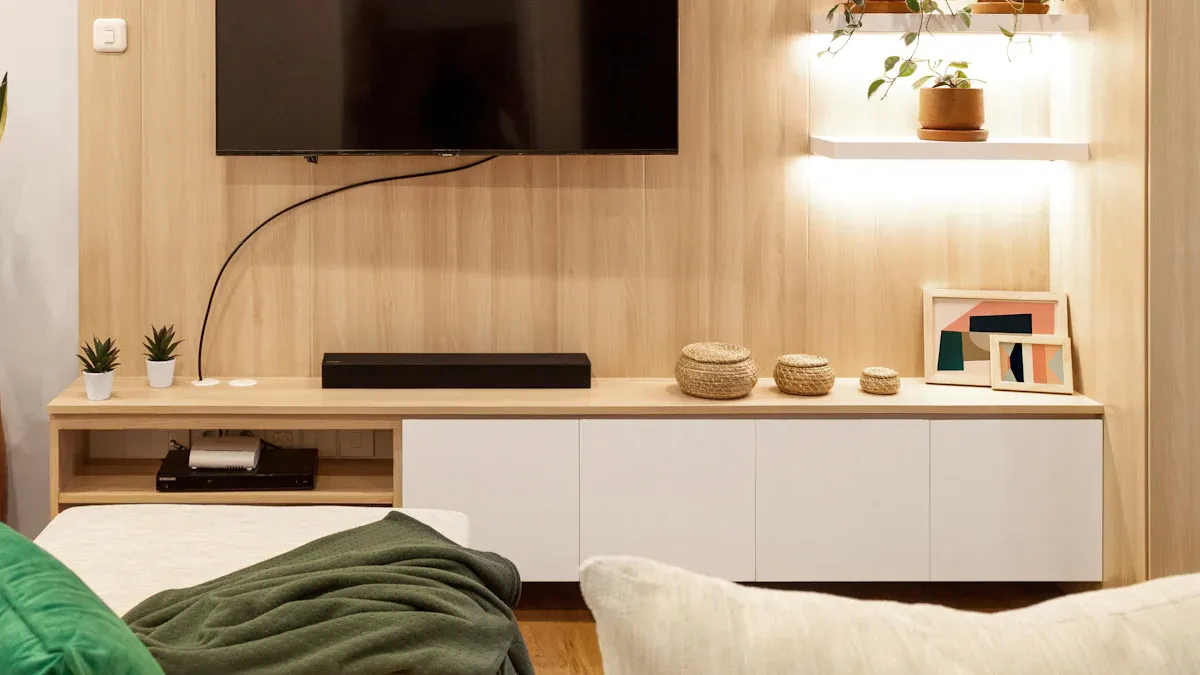
Selecting the proper TV mount transforms a room by enhancing both functionality and style. A secure mount ensures safety while providing the optimal viewing experience. Options like Pro Mounts & Stands or Ergo Mounts & Stands cater to various needs, making them essential for creating a comfortable and clutter-free home entertainment setup.
Key Takeaways
- Pick a TV mount that fits your needs, room, and budget. Fixed mounts cost less and are easy to use. Tilting and full-motion mounts let you adjust the TV more.
- Check your TV’s size, weight, and VESA pattern before buying a mount. This keeps it safe and makes sure it fits well.
- Think about the wall where you’ll put the TV. Different walls need special tools to keep the TV steady and secure.
Types of TV Mounts

Choosing the right TV mount depends on your viewing preferences, room layout, and budget. Each type of mount offers unique features that cater to different needs. Below is an overview of the most common types of TV mounts.
Fixed TV Mounts
Fixed TV mounts are the simplest and most cost-effective option. They hold the TV close to the wall, creating a sleek and minimalist look. These mounts are ideal for spaces where the viewing angle remains consistent, such as living rooms or bedrooms with a central seating arrangement.
Tip: Fixed mounts are perfect for those who prioritize affordability and simplicity.
| Type of Mount | Cost Comparison | Simplicity |
|---|---|---|
| Fixed Mount | Most affordable option | Easy installation |
| Full-Motion Mount | Most expensive option | Complex installation |
Fixed mounts are also easy to install, making them a popular choice for first-time users. However, they lack adjustability, which may limit their functionality in rooms with multiple seating areas or glare issues.
Tilting TV Mounts
Tilting TV mounts offer vertical angle adjustments, making them a versatile choice for various room setups. These mounts are particularly useful for TVs installed higher on walls, such as above fireplaces. The ability to tilt the screen downward improves the viewing experience and reduces neck strain.
- Tilting mounts help reduce glare from windows or overhead lights.
- They strike a balance between the affordability of fixed mounts and the flexibility of full-motion mounts.
This type of mount is an excellent option for spaces with bright lighting or unconventional TV placements. While they provide more functionality than fixed mounts, they remain relatively easy to install and budget-friendly.
Full-Motion TV Mounts
Full-motion TV mounts, also known as articulating mounts, offer the highest level of adjustability. They allow users to tilt, swivel, and extend the TV in multiple directions. This flexibility makes them ideal for large rooms or open-concept spaces where viewers may watch from different angles.
Note: Full-motion mounts are perfect for creating a dynamic viewing experience but require more effort during installation.
These mounts are often the most expensive option, but their versatility justifies the cost for those who value convenience and adaptability. They are also suitable for corner installations or rooms with irregular layouts.
Specialty TV Mounts
Specialty TV mounts cater to unique needs and specific use cases. Examples include ceiling mounts, under-cabinet mounts, and motorized mounts. Ceiling mounts work well in commercial spaces or rooms with limited wall space. Under-cabinet mounts are perfect for kitchens, allowing the TV to fold away when not in use. Motorized mounts add a touch of luxury by enabling remote-controlled adjustments.
These mounts often come with higher price tags and may require professional installation. However, they provide innovative solutions for unconventional setups, enhancing both functionality and aesthetics.
Key Considerations for Choosing a TV Mount
Selecting the right TV mount requires careful evaluation of several factors. These considerations ensure safety, compatibility, and an enhanced viewing experience. Below are the key aspects to keep in mind.
TV Size and Weight
The size and weight of your TV play a crucial role in determining the appropriate mount. A mount must support the TV’s weight to prevent accidents or damage.
- Weight Capacity: Always choose a mount with a maximum weight capacity that exceeds your TV’s weight. This ensures safety and durability.
- TV Screen Size Range: Verify that the mount accommodates your TV’s screen size. Proper alignment and functionality depend on this compatibility.
- VESA Compatibility: Ensure the mount matches your TV’s VESA mounting pattern for a secure fit.
Tip: Manufacturers often provide weight and size guidelines for their mounts. Refer to these specifications to make an informed decision.
Wall Type and Strength
The type of wall where the TV will be mounted significantly impacts the installation process and the mount’s stability. Different wall materials require specific mounting techniques and hardware.
| Specification | Details |
|---|---|
| Outlet Box Type | Dual gang outlet box (e.g., Steel City, part number 72171-3/4) |
| Wall Type Consideration | Use a back brace for steel studded walls |
| Plaster Ring Types | Steel City plaster rings (single gang: 72-C13, double gang: 72-C-17) |
| Standard Mounting Heights | Desk: 18 inches AFF, Handicapped: 48 inches AFF |
Drywall, brick, and concrete walls each require different anchors and screws. For steel-studded walls, a back brace is essential to distribute the weight evenly. Always assess the wall’s strength before installation to avoid structural damage.
VESA Compatibility
VESA (Video Electronics Standards Association) compatibility ensures that the TV mount fits securely with your TV. This standard defines the hole patterns and screw sizes on the back of TVs.
To check VESA compliance, look for a rectangular hole pattern on the back of your TV. Match this pattern with the mount’s specifications. Additionally, consider the weight and screen size guidelines provided by VESA to avoid compatibility issues.
Note: VESA standards simplify the selection process, making it easier to find a mount that fits your TV perfectly.
Viewing Angle and Room Layout
The viewing angle and room layout directly influence the TV’s placement and the type of mount required. A well-positioned TV enhances the viewing experience and reduces strain on the eyes and neck.
| Factor | Impact on TV Viewing Experience |
|---|---|
| Display Curvature Radius | Increases display field of view, enhancing spatial presence and engagement. |
| Viewing Distance | Closer distance increases field of view, reducing visual discomfort and fatigue. |
| Lateral Viewing Position | Affects viewing angles, with less variation improving image quality and user satisfaction. |
| Viewing Angle | Wider angles can lead to perceived distortion, negatively affecting image quality and comfort. |
For rooms with multiple seating areas, a full-motion mount offers the flexibility to adjust the TV’s position. In contrast, fixed or tilting mounts work well for spaces with a consistent viewing angle.
Cable Management Features
A clutter-free setup enhances the aesthetics of your entertainment area. Many TV mounts include built-in cable management systems to organize and conceal wires.
Tip: Look for mounts with channels or clips that keep cables neatly tucked away. This not only improves the room’s appearance but also prevents tripping hazards.
According to Consumer Reports, wall-mounted TVs not only enhance the aesthetic appeal of a room but also contribute to safety by preventing tip-overs. This highlights the importance of considering both functionality and design when selecting a TV mount.
Installation Tips for Your TV Mount

Proper installation of a TV mount ensures safety, stability, and an optimal viewing experience. Following the right steps and using the correct tools can make the process straightforward and efficient.
Tools You’ll Need
Having the right tools on hand simplifies the installation process and ensures accuracy. Essential tools include:
- A stud finder to locate wall studs for secure mounting.
- A power drill with appropriate drill bits for creating holes.
- A level to ensure the mount is perfectly horizontal.
- A screwdriver set for tightening screws and brackets.
- Measuring tape to mark precise drilling points.
- Safety gear, such as gloves and goggles, to protect against injuries.
Tip: Always read the installation manual provided with the TV mount to familiarize yourself with the required tools and steps.
Step-by-Step Installation Process
Installing a TV mount involves several key steps. Following these ensures a secure and professional setup:
- Prepare for installation: Identify the wall type and use a stud finder to locate studs for added stability.
- Attach the wall plate: Mark the drilling points using a level, drill the holes, and secure the wall plate to the wall.
- Hang the TV: Carefully lift the TV and attach it to the wall plate, ensuring it locks into place.
- Adjust the viewing angle: Modify the tilt, swivel, or extension settings to achieve the desired viewing position.
- Cable management: Use the mount’s built-in cable management system to organize and conceal wires for a clean look.
Note: Periodically check the tightness of screws and brackets to maintain safety over time.
Common Mistakes to Avoid
Avoiding common errors during installation can save time and prevent potential damage:
- Skipping stud detection: Mounting directly onto drywall without locating studs can lead to instability.
- Neglecting levelness: An uneven mount results in a tilted TV, affecting the viewing experience.
- Overtightening screws: Excessive force can damage the wall or the mount.
- Ignoring weight limits: Using a mount that cannot support the TV’s weight increases the risk of accidents.
By following these tips and avoiding mistakes, users can ensure their TV mount is installed securely and functions effectively.
Choosing the right TV mount enhances safety, functionality, and viewing comfort. Evaluating TV specifications, wall type, and personal preferences ensures an informed decision. Professional mounting services provide secure installation, cable management, and expert placement advice. These benefits deliver long-term satisfaction, creating a clutter-free setup that complements any room’s design and layout.
FAQ
What is the best type of TV mount for a small room?
A tilting or fixed TV mount works best for small rooms. These mounts save space and provide a clean, minimalist look.
Can a TV mount be installed on any wall type?
Not all walls are suitable for mounting. Drywall requires studs, while brick or concrete walls need specialized anchors for stability.
Tip: Always assess wall strength before installation to avoid accidents.
How do I know if my TV is compatible with a mount?
Check the TV’s VESA pattern, weight, and size. Match these specifications with the mount’s guidelines to ensure compatibility.
Note: Manufacturers often list VESA details in the TV manual or product description.
Post time: Apr-25-2025

